A classic Sichuan dish, dry fried green beans deliver a wonderful combination of flavours. This recipe introduces three ways to dehydrate the beans without deep-frying. Vegan options provided.
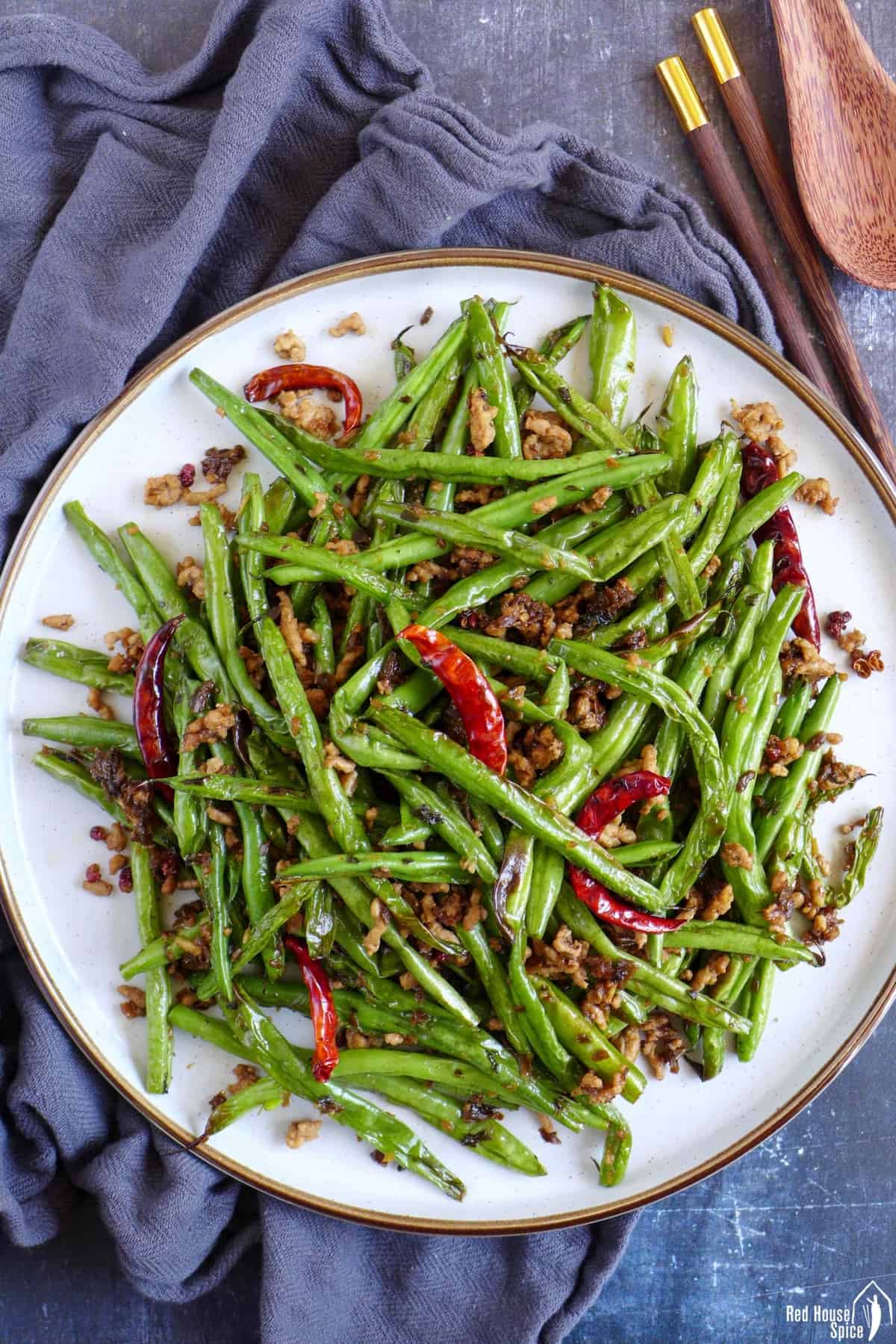
A classic Sichuan dish
Today I’m sharing a very tasty stir-fry dish which, I believe, is the most delicious way to cook green beans: Sichuan dry fried green beans (Gan Bian Si Ji Dou, 干煸四季豆). The beans are blistered to a soft texture then stir-fried with a set of classic ingredients of Sichuan cuisine.
It delivers a sophisticated, exciting flavour combination: aromatic, umami, spicy, numbing, salty with a hint of sweetness. If you haven’t tried this dish before, I’m pretty confident that you will fall in love with it at the first bite.
What is “dry fry”?
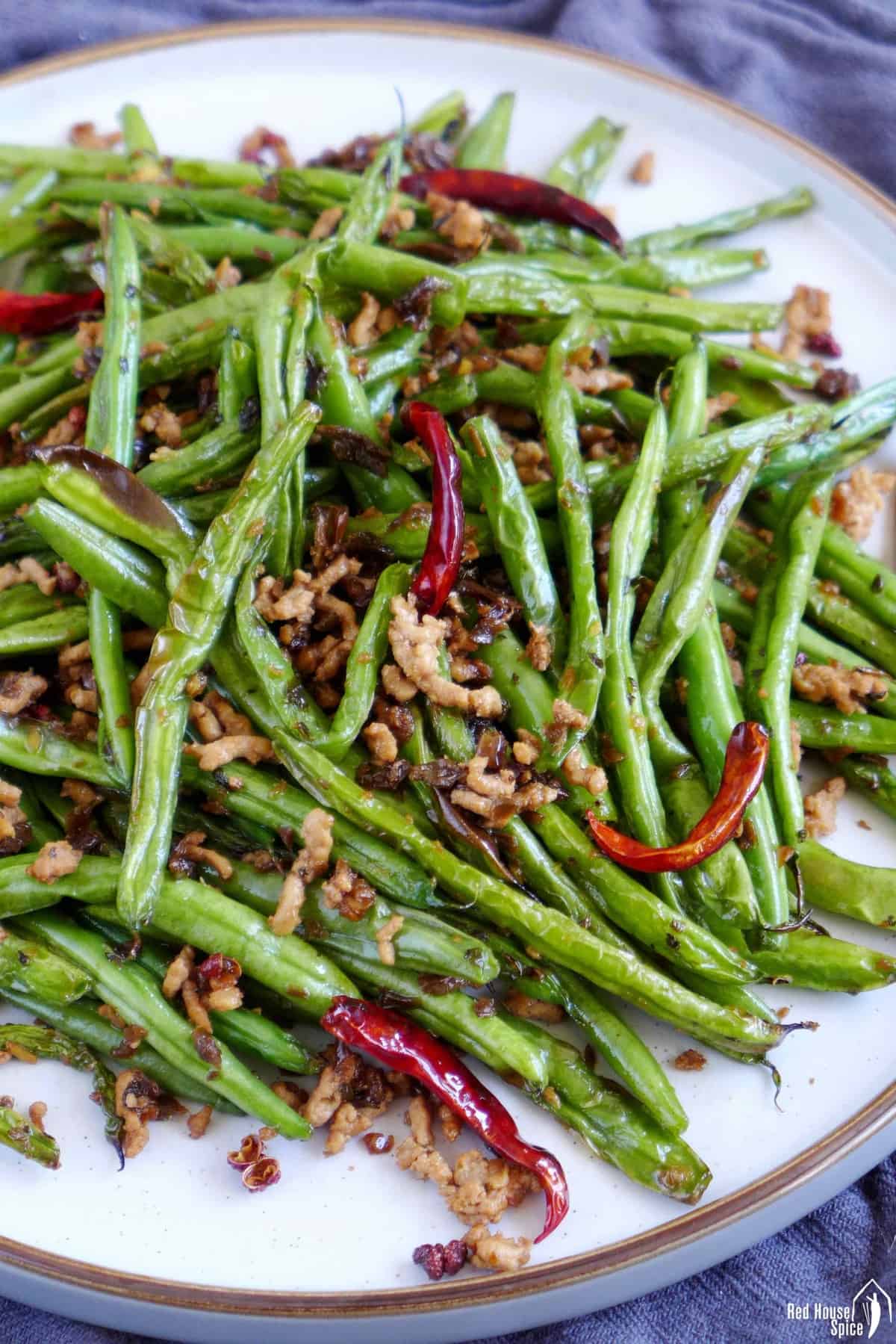
Dry fry, known as Gan Bian (干煸) in Chinese, is a term used in Chinese cuisine to describe the process of dehydrating meat or vegetables. It’s particularly popular in Sichuan cooking. Dry fried dishes share two key features:
- They look dry and there is no liquid or sauce in the dish.
- They’re often seasoned with pungent spices, such as dried chilies, Sichuan pepper, etc.
Dry Fried Cauliflower, Spicy Potato Pancake and today’s dry fried green beans are some of the popular examples.
Ingredients

Here is what you need to cook dry fried green beans:
- Green beans
- Minced meat (pork, beef or chicken)
- Ya Cai (Sichuan preserved mustard greens)
- Dried chilies & Sichuan peppercorn
- Shaoxing rice wine & light soy sauce
- Minced garlic & ginger
- Salt & oil
Vegan option
Although minced meat is indispensable for the classic version of this dish, I sometimes skip it and the taste is still great. In this case, make sure you don’t alter other spices and seasoning.
Another alternative is to use Shiitake mushrooms as a substitute. The dried ones are preferable as they have a more intense flavour than fresh ones. Soak them beforehand and chop them small prior to cooking.
Ya Cai & its substitutes
Ya Cai (芽菜), known as Sichuan preserved mustard greens, is a type of fermented vegetable unique to Sichuan cuisine. It provides an intense umami taste and a balanced sweet-salty flavour. Paired well with minced meat, it’s an essential ingredient for classic dishes like Dan Dan noodles, as well as for today’s dry fried green beans.
What I used for this recipe is Sui Mi Ya Cai (碎米芽菜) which is minced, ready-to-use Ya Cai (left in image below). It comes in plastic sachets and is available in Chinese stores and online shops like Amazon, etc.
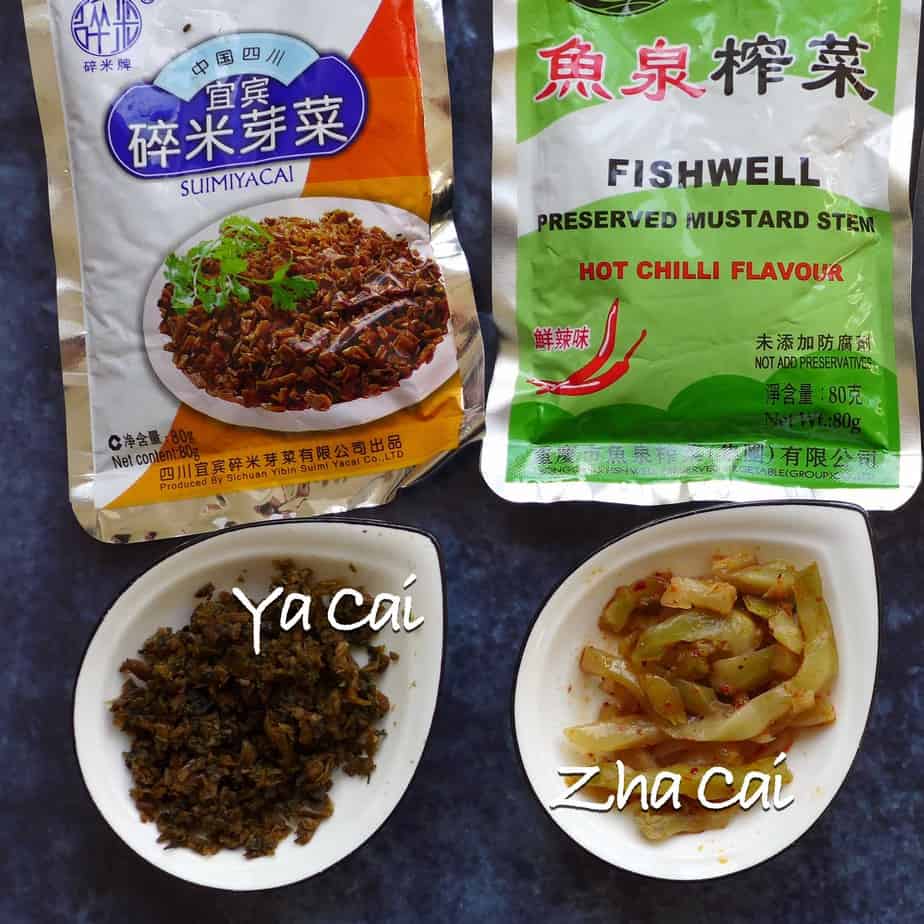
If Ya Cai is unavailable, you may use other types of fermented ingredients as a substitute. The taste of the dish would be a little different, but equally delicious. Here are a few examples:
- Zha Cai (榨菜), preserved mustard stem (right in image above)
- Dong Cai (冬菜), Tianjin preserved vegetable
- Gan Lan Cai (橄榄菜), Chinese olive vegetable
- Duo Jiao (剁椒), pickled chili garlic sauce
🛎 Note: You may need to adjust the volume as these ingredients contain different levels of salt.
Three ways to dehydrate the beans
As I mentioned earlier, the crucial part of making this dish is to “dry” (dehydrate) the green beans before frying them with other ingredients. In Chinese restaurants, it’s a common practice to deep fry the beans. This is not a good method for everyday home cooking though.
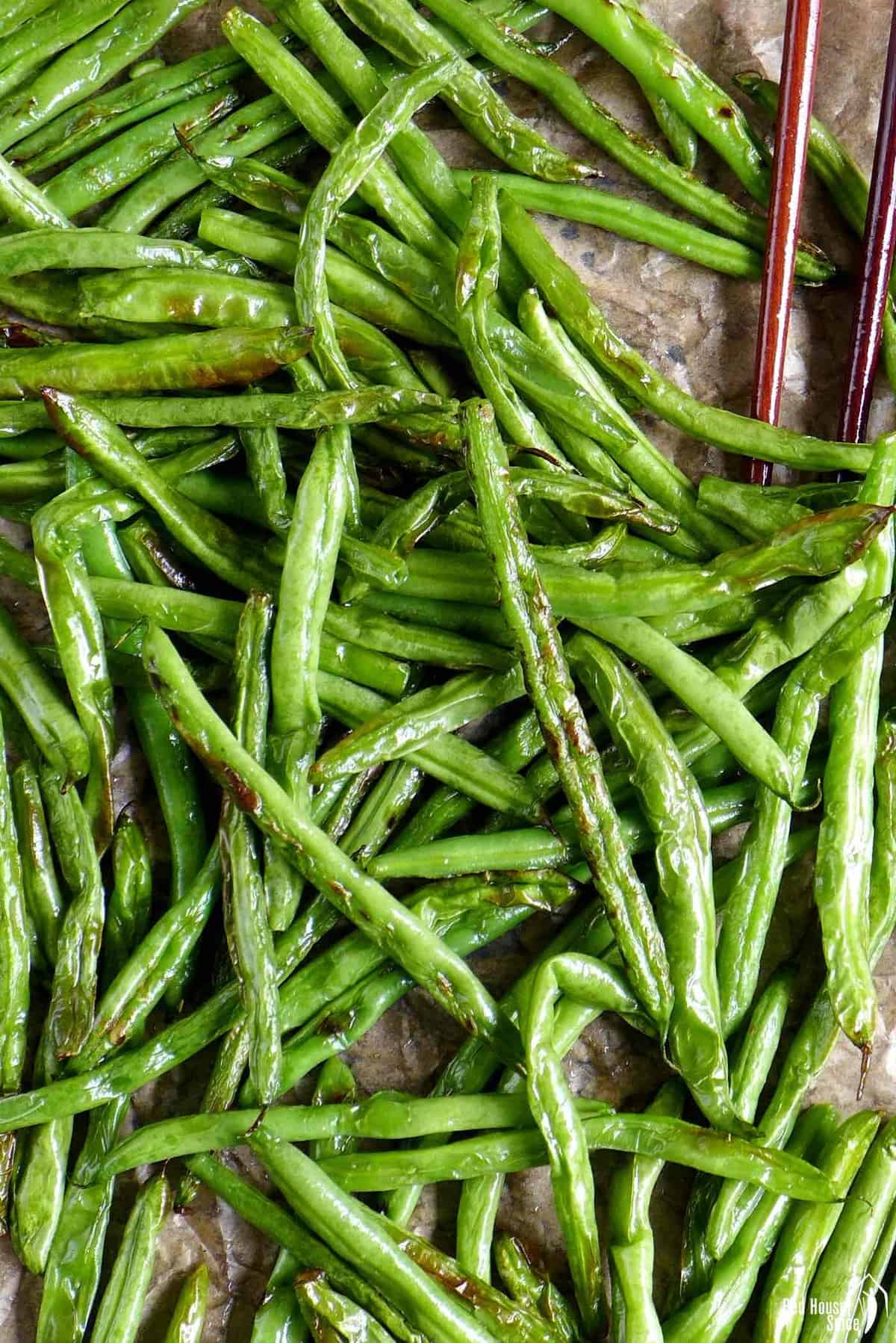
The good news is that there are three alternative ways which lead to the same result but only a small amount of oil is required. No matter which method you’re using, coat the green beans with salt and oil beforehand (The most effective way is to add everything to a resealable bag then rub and shake).
Option 1: Roasting in the oven
Preheat the oven at 220°C / 425°F (Fan assisted at 200°C / 390°F). Roast the bean in a single layer for 12-15 mins.
Option 2: Air-frying (my favourite method)
Preheat the air-fryer at 200°C / 390°F for 3 mins. Add the beans then cook for 6-8 mins. Shake twice during the process.
Option 3: Wok/Pan-frying
Add the beans to an empty wok or deep frying pan(skillet). Turn the heat to medium-high. Fry for 12-15 mins. Stir and flip frequently for an even result.
🛎 Note: The cooking time required may vary depending on the performance of your appliance and the size of the green beans. Observe closely and take out the beans as soon as they become pliable and slightly blistered.
The stir-fry process
Once all the beans are nicely dehydrated, you’re ready to combine all the ingredients in a very quick stir-fry.
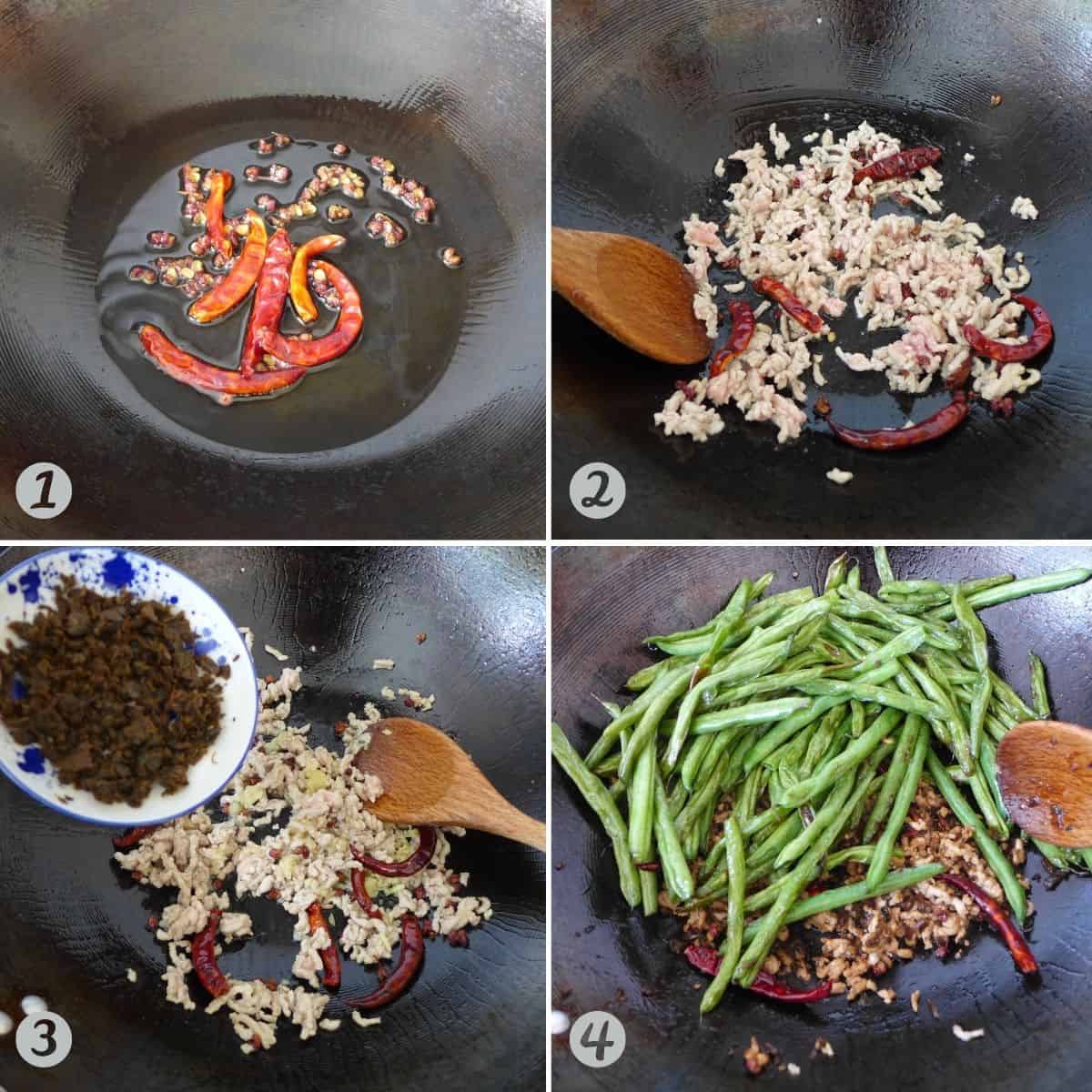
- Pour oil into a wok or deep frying pan. Over high heat, fry dried chilies and whole Sichuan pepper first.
- Once the spices become fragrant (be careful not to burn), stir in minced meat and Shaoxing rice wine. Fry until the meat turns pale.
- Add Ya Cai (or its substitute), minced ginger and garlic and soy sauce. Fry for a minute or so.
- Put in pre-cooked green beans. Stir well to mix and combine everything.
Tips on using a traditional wok
If you’re using a carbon steel wok without a non-stick coating, it is important that you heat up the wok first (empty). Once it becomes very hot, add oil and follow the procedure. This traditional “Hot Wok Cold Oil” method (known as Re Guo Liang You/热锅凉油) is very effective at preventing the meat from sticking.
🛎 Note: If using non-stick cookware, make sure you never heat it when empty.
Other Sichuan dishes
Looking for more classic recipes from Sichuan cuisine? Here are a few popular ones to try:
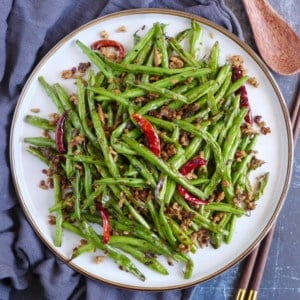
Sichuan Dry Fried Green Beans (干煸四季豆)
Ingredients
For the beans
- 350 g green beans - about 12oz
- 1 tablespoon neutral cooking oil
- ¼ teaspoon salt
For stir-frying
- 1 tablespoon neutral cooking oil
- 1 teaspoon whole Sichuan peppercorn
- 6 dried chilies - or to taste
- 80 g minced meat (pork, beef or chicken) - about 3oz, see note 1 for vegan options
- 1 teaspoon Shaoxing rice wine
- 1 tablespoon minced garlic
- 1 teaspoon minced ginger
- 1½ tablespoon Ya Cai (Sichuan preserved mustard greens) - see note 2 for substitutes
- 1 teaspoon light soy sauce
- ½ teaspoon dark soy sauce
Instructions
Prepare the beans
- Wash green beans and trim off the stem end. Pat dry with a clean tea towel.
- Put the beans, salt and oil into a resealable plastic bag. Shake and rub around to evenly coat the beans.
Dehydrate the beans (see note 3 & 4)
- Option 1: Oven Roasting: Place the beans onto a roasting tray (large enough to avoid overlapping). Cook in a preheated oven at 220°C / 425°F (Fan 200°C / 400°F) for 12-15 minutes until the beans become slightly charred and blistered.
- Option 2: Air Frying: Preheat the air-fryer at 200°C / 390°F for 3 mins. Add the beans then cook for 6-8 mins until they become pliable and blistered (Shake twice during the process).
- Option 3: Pan Frying: Add the beans to an empty wok or deep frying pan(skillet). Turn the heat to medium-high. Fry for 12-15 mins. Stir and flip frequently for an even result. Dish out when they are slightly charred and blistered.
Stir-fry the dish
- Heat 1 tablespoon of oil in a wok (or deep frying pan) over a high heat. Fry Sichuan peppercorn and dried chillies until fragrant (do not burn).
- Stir in minced meat and Shaoxing rice wine. When the meat becomes pale, add garlic, ginger, Ya Cai and soy sauce. Fry for 1 minute or so.
- Add the pre-cooked beans. Stir well to mix and combine everything. Serve immediately with plain rice and other savoury dishes.
NOTES
NUTRITION
NUTRITION DISCLOSURE: Nutritional information on this website is provided as a courtesy to readers. It should be considered estimates. Please use your own brand nutritional values or your preferred nutrition calculator to double check against our estimates.


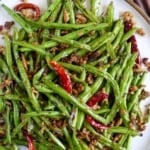
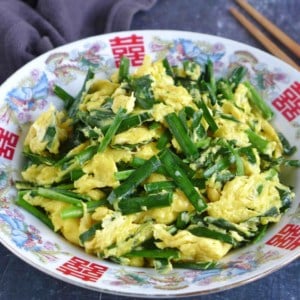

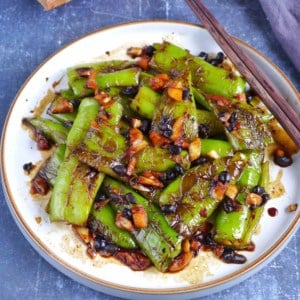

I lived in China for many years. Back in Belgium, i miss the Chinese (and certainly the Sichuan) cuisine. I always thought it would be very hard to prepare Chinese food. Frustrated by the quality of Chinese restaurants, i started looking for recipes. That’s how i came to know your website. A treasure !
Up to now, i made the dry fried green beans and gongbao jiding. Both of them delicious.
Thank you so much for sharing !
My pleasure to share Pascale! Yes, many Sichuan dishes can be easily made at home. Glad you enjoyed my recipes. Hope you’ll find more inspiration.
This is one of the best vegetable dishes to date, thanks for the recipe!
I just want to add, that if you are out of minced meat, finely chopped cured ham (not smoked) with a thick layer of fat works aswell.
I even had to substitute ya-cai with pickled Chilis (which is a marvelous ingredient anyway) and it worked out deliciously.
I like how you twisted the recipe. It sounds delicious!
Are the beans supposed to have a slightly chewy texture at the end?
Yes, they are supposed to have a slightly chewy texture once cooked.
Good to know! I liked it, but my mom doesnt like the chewy texture sadly :/